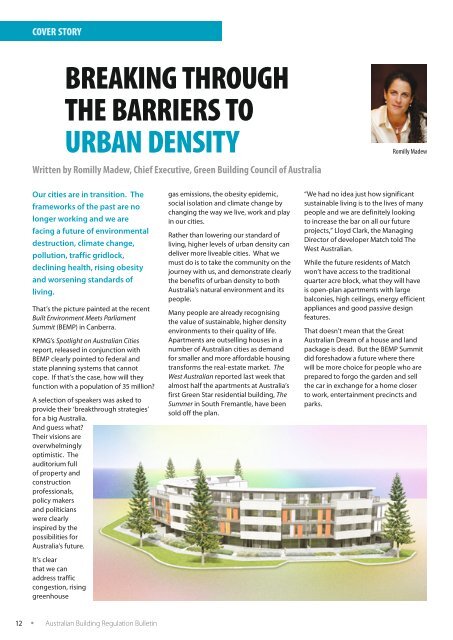PDF | 8 MB - Australian Building Codes Board
PDF | 8 MB - Australian Building Codes Board
PDF | 8 MB - Australian Building Codes Board
Create successful ePaper yourself
Turn your PDF publications into a flip-book with our unique Google optimized e-Paper software.
COVER STORY<br />
Breaking through<br />
the barriers to<br />
urban density<br />
Romilly Madew<br />
Written by Romilly Madew, Chief Executive, Green <strong>Building</strong> Council of Australia<br />
Our cities are in transition. The<br />
frameworks of the past are no<br />
longer working and we are<br />
facing a future of environmental<br />
destruction, climate change,<br />
pollution, traffic gridlock,<br />
declining health, rising obesity<br />
and worsening standards of<br />
living.<br />
That’s the picture painted at the recent<br />
Built Environment Meets Parliament<br />
Summit (BEMP) in Canberra.<br />
KPMG’s Spotlight on <strong>Australian</strong> Cities<br />
report, released in conjunction with<br />
BEMP clearly pointed to federal and<br />
state planning systems that cannot<br />
cope. If that’s the case, how will they<br />
function with a population of 35 million?<br />
A selection of speakers was asked to<br />
provide their ‘breakthrough strategies’<br />
for a big Australia.<br />
And guess what?<br />
Their visions are<br />
overwhelmingly<br />
optimistic. The<br />
auditorium full<br />
of property and<br />
construction<br />
professionals,<br />
policy makers<br />
and politicians<br />
were clearly<br />
inspired by the<br />
possibilities for<br />
Australia’s future.<br />
It’s clear<br />
that we can<br />
address traffic<br />
congestion, rising<br />
greenhouse<br />
gas emissions, the obesity epidemic,<br />
social isolation and climate change by<br />
changing the way we live, work and play<br />
in our cities.<br />
Rather than lowering our standard of<br />
living, higher levels of urban density can<br />
deliver more liveable cities. What we<br />
must do is to take the community on the<br />
journey with us, and demonstrate clearly<br />
the benefits of urban density to both<br />
Australia’s natural environment and its<br />
people.<br />
Many people are already recognising<br />
the value of sustainable, higher density<br />
environments to their quality of life.<br />
Apartments are outselling houses in a<br />
number of <strong>Australian</strong> cities as demand<br />
for smaller and more affordable housing<br />
transforms the real-estate market. The<br />
West <strong>Australian</strong> reported last week that<br />
almost half the apartments at Australia’s<br />
first Green Star residential building, The<br />
Summer in South Fremantle, have been<br />
sold off the plan.<br />
“We had no idea just how significant<br />
sustainable living is to the lives of many<br />
people and we are definitely looking<br />
to increase the bar on all our future<br />
projects,” Lloyd Clark, the Managing<br />
Director of developer Match told The<br />
West <strong>Australian</strong>.<br />
While the future residents of Match<br />
won’t have access to the traditional<br />
quarter acre block, what they will have<br />
is open-plan apartments with large<br />
balconies, high ceilings, energy efficient<br />
appliances and good passive design<br />
features.<br />
That doesn’t mean that the Great<br />
<strong>Australian</strong> Dream of a house and land<br />
package is dead. But the BEMP Summit<br />
did foreshadow a future where there<br />
will be more choice for people who are<br />
prepared to forgo the garden and sell<br />
the car in exchange for a home closer<br />
to work, entertainment precincts and<br />
parks.<br />
12 • <strong>Australian</strong> <strong>Building</strong> Regulation Bulletin

















